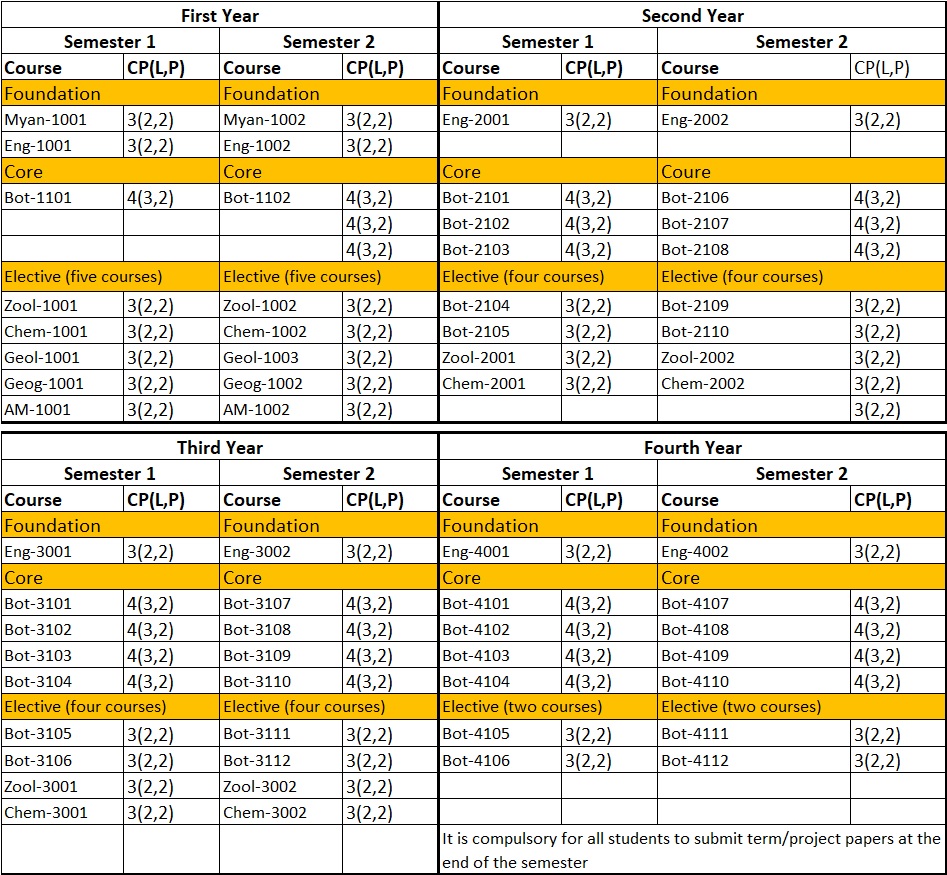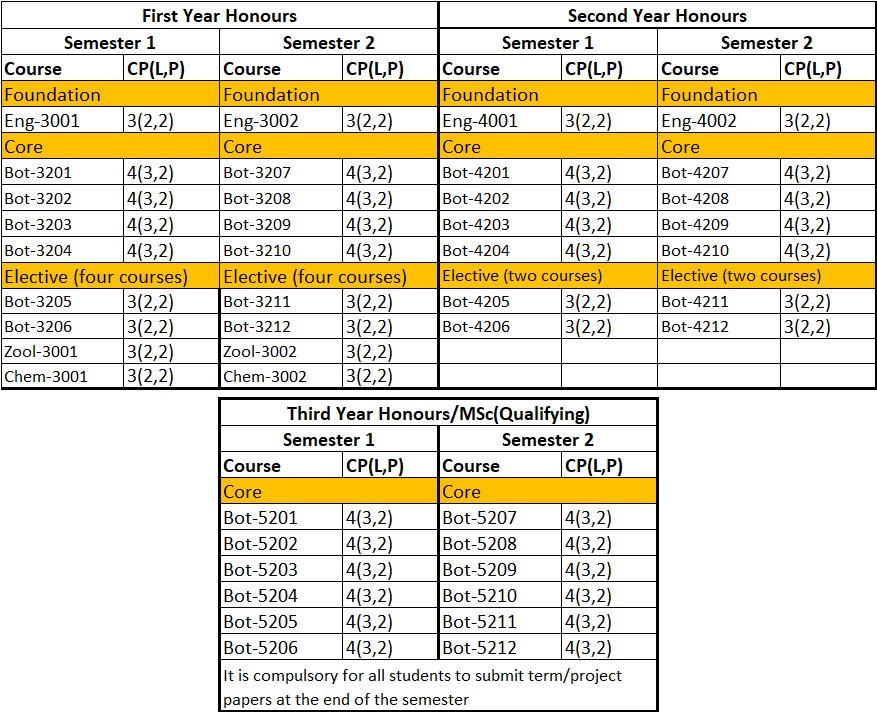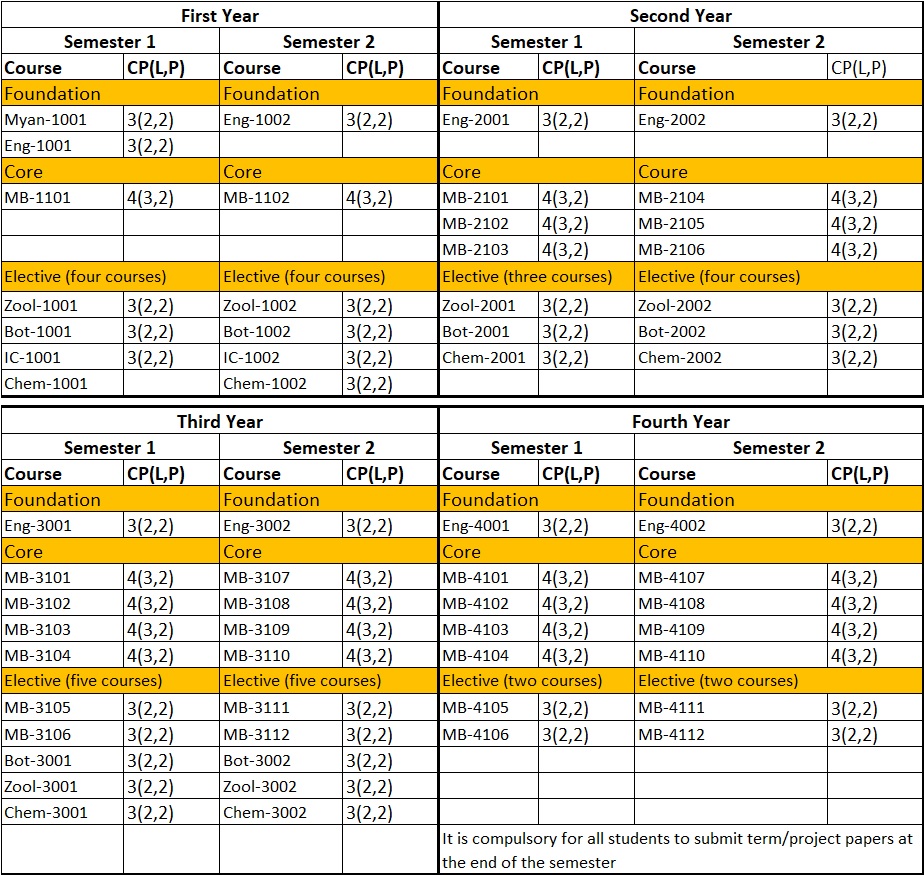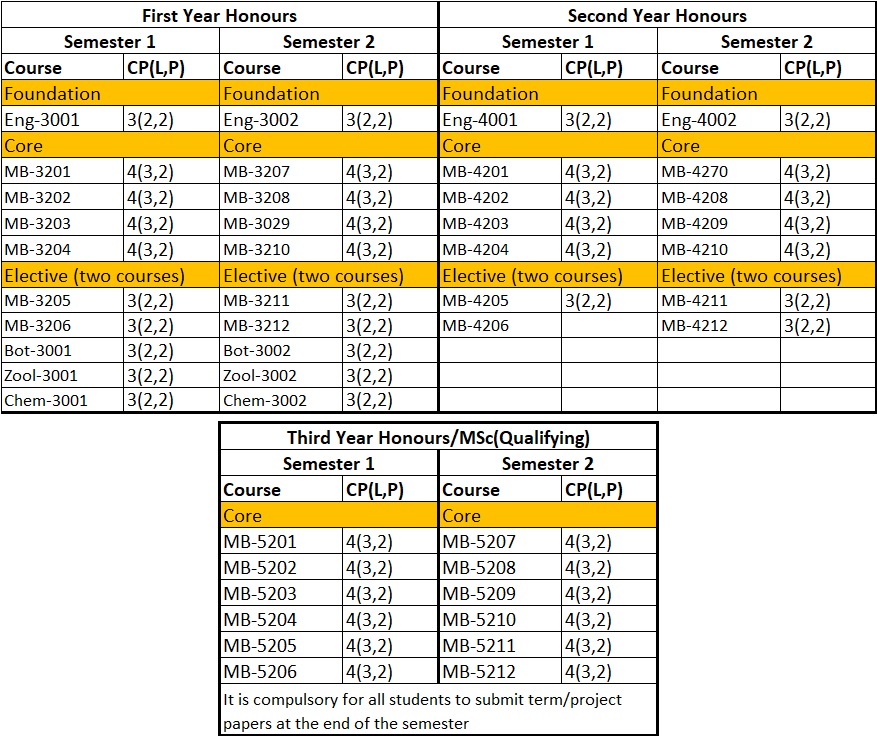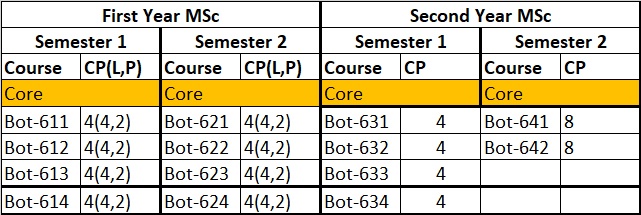Categories
Science Department of Botany and Microbiology
Department of Botany and Microbiology
 |
Dr Win Naing Department of Botany Professor PhD (Microbiology) Department of Botany and Microbiology, Yadanabon University,Mandalay, Myanmar (+95-09402533790) drwinnaing.micro@gmail.com |
Staff
| Professor | – | 3 |
| Associate Professor | – | 5 |
| Lecture | – | 5 |
| Assistant Lecturer | – | 2 |
| Tutor | – | 15 |
| Total | – | 20 |
History of the Department
History of the Department
The origin of the Department of Botany in the Yadanabon University started in the academic year 2000-2001. Microbiology was also taught in 2004. This department offers BSc, BSc (Hons.) and MSc in Botany and Microbiology.
Vision
- To produce human resources who teaching and conducting research to keep pace with the scientific progress and the requirement of society
Mission
- To enhance scientific research through strategic planning and a clear vision for science and technology at country’s level
- To train national cadres to introduce a methodology development to meet the different needs of society and
- To serve the various research and development projects in the community
Programs Offered
| BSc / BSc (Hons.) in Botany |
| MSc in Botany |
| BSc / BSc (Hons.) in Microbiology |
| MSc in Microbiology |
Curriculum
BSc in Botany
BSc (Honours) in Botany
Students who passed second year with GPA greater than 4 are eligible to attend BA (Honours) classes for three more years. After finished successfully, they are earned BA (Hons) degree majoring in Library and Information Studies.
BSc in Microbiology
BSc (Honours) in Microbiology
Students who passed second year with GPA greater than 4 are eligible to attend B.Sc. (Honours) classes for three more years. After finished successfully, they are earned B.Sc. (Hons.) degree majoring in Microbiology.
MSc in Botany
Students who passed B.Sc. (Honours)/ Qualifying Class with GPA greater than 4 are eligible to attend MSc classes for two years. After finished successfully, they are earned MSc degree majoring in Botany.
MSc in Microbiology
Students who passed B.Sc. (Honours)/ Qualifying Class with GPA greater than 4 are eligible to attend MSc classes for two years. After finished successfully, they are earned MSc degree majoring in Microbiology.
Descriptions Modules Offered
Chapter I. Botany as A Science
Chapter II. The Origin of Life
Chapter III. Cell, Tissue and Organ
Chapter IV. Diversity of Plants
Chapter V. Absorption and Transport
Chapter VI. Plant Nutrition
Chapter VII. Energy in Plants
Chapter VIII. Plant Growth
Chapter IX. Plant Reproduction
Chapter X. Plant Heredity
Chapter XI. Plants and their Environments
References
- Anderson, S.H., R.E. Beiswenger and P. Walton. 1987. Environmental Science, Merrill Publishing Campany. A. Bell &Howell Information Company.
- Arms, K. and Camp, P. 1987. Biology. Saunders, New York.
- Audesirk, G. and T. Audesirk. 1989. Biology. Macmillan Publishing Co., New York, London.
- Backer, J. J.W. and G.E. Allen. 1979. A Course in Biology. Addison-Wesley Publishing
Co., California, London, Amsterdam, Don Mills, Ontario, Syndey. - Barbour, M.G. and T.L.Rost. 1982.Botany: An Introduction to Plant Biology.John
Wiley and Sons Inc.
Part 1. Seed technology
Part 2. Important role of photosynthesis in our ecosystem
Part 3. Food, medicine, clothing and shelter
Part 4. Plant hormones and plant technology
Refereces
- Anderson, S. H., R. E. Beiswenger and P. Walton. 1987. Environmental Science, Merr Publishing Company. A. Bell & Howell Information Company
- Audesirk, G and T. Audesirk,, 1989. Biology. Macmillan Publishing Co, New York, London
- Hill A. F, 1952. Economic Botany. Mc. Graw-Hill Book Company, INC.
- Keller A. Edward and Botkin A. Daniel. 1989, Environmental Studies (Earth as a Living Plant) Second Edition. Merill Publishing Company London. U. K.
Mader, S. Sylvia, 1998. Biology. 6h ed. WCB/Mc. Graw-HillA division of The Mc. Graw-Hill Companies. U.S.A.
Chapter I. Categorizing the Varieties of Plants and their Relatives
Chapter II. The Invisible Kingdom Virus
Chapter III. Kingdom: Monera
Chapter IV. Kingdom: Protista
Chapter V. Kingdom: Fungi
Chapter VI. Kingdom: Plantae
References
- Anderson, S. H., R. E. Beiswenger and P. Walton. 1987. Environmental Science, Merill Publishing Company.A. Bell & Howell Information Company.
- Arms, K. and Camp, P. 1987. Biology Saunders, New York.
- Audesirk, G and T. Audesirk. 1989, Biology. Macmillan Publishing Co., New York, London.
- Backer, J. J. W. and G E. Allen. 1979. A Course in Biology. Addison-Wesley Publishing , California, London, Amsterdam, Don Mills, Ontario, Sydney.
- Barbour, M. G and T. L. Rost. 1982. Botany: An Introduction to Plant Biology. John Wiley and Sons Inc.
Chapter I. Plants and Man
Chapter II. Plants and Environment
References
- Anderson, S. H., R. E. Beiswenger and P. Walton. 1987. Environmental Science, Merrill
ublishing Company. A. Bell & Howell Information Company - Audesirk, G and T. Audesirk, 1989. Biology Macmillan Publishing Co., New York
London - Hill A. F. 1952. Economic Mc. Graw-Hill Book Company, INC
- Keller A. Edward and Botkin A. Daniel. 1989. Environmental Studies (Earth as a
Living Plant) Second Edition. Merrill Publishing Company, London. U. K.
Mader, S. Sylvia, 1998. Biology. 6th ed. WCB/Mc. Graw-Hill A division of The Mc.
Graw-Hill Companies. U.S.A
Chapter I. Introduction
Chapter II. Prokaryotic Algae
Chapter Ill. Eukaryotic Algae
Chapter IV. Protistic Algae
Chapter V. Division Phaeophyta
Chapter VI. Division Rhodophyta
Chapter VII. Division- Xanthophyta
Chapter VIII. Economic Importance of Algae
References
- Michel G. Simpson (2006). “Plant Systematics” Elsevier Acadamic Press.
- Pandey, S.N, S.P Misra, P.S Trivfdi. “A Text book of Botany Vol. II.” 11th Edition (1998). University of Kanpur.
- Smith, G.M. (1955). ” Cryptogamic Botany I1.Bryophytes and Pteridophytes Me Graw Hill Book Company, Inc.
- Tin Myint, (1972). “Bryophytes and Protracheaphytes”. University Press, Yangon (Myanmar).
- Yin Htay, Daw (1992). “Bryophytes-Survey of Plant Kingdom Part I”.
Section I. Fossil
Section II. Pteredophyta (Tracheophyta)
Section III. Gymnosperms (Spermatophyta)
Section IV. Relative Plants Of Fungi
References
- Michel G. Simpson (2006). “Plant Systematic Elservier Acadamic Press. Chester
- Chand’s. S, (1999). “Simplified Course in Botany B.Sc.1, B.P. Andy S. Chan and Company LTD. Ram Nagar, New Delhi.
- Dube H. C. (2000) An Introduction to Fungi. Printed at Vishal Printers Delhi 110-032.
- Dutta, A.C. (1983). ” Botany for Degree Students” Fifth Edition, Oxford University Press.
John Webster (1999) Introduction to Fungi. Cambridge University Press, New York, Port, Melbourne Sydnye.
Chapter I- Classification
Chapter II- Nomenclature of Plants
Chapter III- Principles of taxonomy and Phylogeny of Angiosperms
Chapter IV- Basal Angiosperms
Chapter V- Magnoliids
Chapter V- Monocots
Chapter VII- Eudicots
Refrences
- APG, 2009. An Update of the Angiosperm Phylogeny Group classification for the orders and families of flowering plants: APG III by The angiosperm Phylogeny Group. Botanical Journal of the Linnean Society 161: p105-121.
- Heywood, V.H., R.K. Brummitt, A. Culham & O. Seberg, 2007. Flowering Plant Families of the World. Friendly Books, Richmond Hill, Canada.
- Judd, W.S., C. S. Campbell, E. A. Kellogg, P.F. Stevens & M. J. Donoghue, 2002. Plant Systematics, A Plylogenetic Approach. Sinaur Asociates, Inc. U.S.A.
- Pandey, B. P., 1999. Taxonomy of Angiosperms. S. Chand & Company LTD. Ram Nagar, New Delhi-110055.
Simpson, M.G., 2006. Plant Systematics. Elsevier Academic Press, London.
Chapter I. Mendelian Inheritance
Chapter II. Genes Interaction and Lethality
Chapter III. Allelism
Chapter IV. The Genetics of Sex
Chapter V. Quantitative, Polygenic, or Multiple Factor Inheritance
Chapter VI. Genes in Population
References
- Burns, G. W. 1983. The Science of Genetics, An Introduction to heredity. 5h Edition, N. Y.Collier Macmillan Publishing Co., INC. New York. ISBN 0-02-317120-0
- Elrod, S. L., W. D. Stansficld, 2002. Theory and Problems of Genetics. Schaum’s Outline Series, 4h Edition, McGraw-Hill Book Companies. ISBN 0-07-136206-1
- Gardner, E. J., M. J. Simmons, & D. P. Snustad, 1991. Principles of Genetics. 8th Edition. John Wiley & Sons, New York. ISBN 0471-50487-4.
- Benjamin A., 2003. Genetics: A Conceptual Approach. Macmillan Higher Education, W.H. Freeman & Company. ISBN 1572591609,
- Srb, A. M., R. D. Owen, R. S. Edgar, 1965. General Genetics. 2nd Edition, H Freeman and Company, San Francisco. Library of Congress Catalog Card No. 65-19558.
Chapter 1. Identification of genetic materials
Chapter 2. Chromosome and chromosome structure
Chapter 3. Chromosome aberration
Chapter 4. Linkage, crossing over and genetic mapping of chromosome
Chapter 5. Polyploidy
Chapter 6. Epigenetics
References
- Michal Inbar- Feigenberg, M. D., S. Choufani, D. T. Butcher, M. D. Maian Roifman and M. D. Rosanna Weksberg, 2013. Basic concepts of epigenetics. American society for Reproductive Medicine, Published by Elsevier Inc. vol.99:3, 6.7-615.
- Frimerose, S. B. and R. M. Twyman. 1976. Principle of Gene manipulation and Genomics 7th Blacdwell Publishing, Australia.
- Riger, R., et al., 1976. Glossary of Genetics and Cytogenetics. 7th Ed. Spinger Varlag Verlin Hideberg. New York.
- Shukla, R. S. and P. S. Chandel. 2007. Cytogenetic, Evolution, Biostatistics and Plant Breeding. S. Chancel and Company Limited.
Strickverger, M. W., 1965. Genetics 3rd Mc Millan Pub. Com. New York.
Chapter I. Introduction
Chapter II. Environment of Plants: Climate Factor
Chapter III. Environment of Plants: Edaphic Factor
Chapter IV. Environment of Plants: Topographic Factor
Chapter V. Environment of Plants : Biotic Factor
Chapter VI. Species and Population
Chapter VII. Ecosystems and Living Organisms
Refernces
- Arora, Mohan P, 2001. ECOLOGY. 4h Revised & Enlarged Edition. Himalay and Publishing House India.
- Johnson, George B., and Jonathan B. Losos, 2008. THE LIVING WORLD. MeGraw-Hi Companies Inc. ISBN 978-0-07-298667-0
- Rana, S. V. S., 2003. ESSENTIALS OF ECOLOGY AND ENVIRONMENTAL Prentice-Hall of India, Delhi. ISBN 81-203-2320-3
- Pcter H. and George B. Johnson, 2002. BIOLOGY. 6 Edition. MacCiraw H Companies, Inc. 1SBN0-07-112261-3
- Verma, P. S. and V. K. Agarwal, 2009. 14h Edition. S. Chad & Company Ltd. India. ISBN
81-219-2442-1.
Chapter 1. Introduction to Horticulture
Chapter 2. Growth and Development
Chapter 3. Climate and Soil (Abiotic Factors)
Chapter 4. Plant Propagation
Chapter 5. Post Production Technology
Chapter 6. Landscaping
References
- Bautista, 0. K. 1994 Introduction to Tropical Horticulture. Second Fdition SEAMEO Regional Center for Graduate Study and Rescarch in agriculture (SEAMEO SEARCA) and University of the Philippines Los Baños (UPLB), Laguna 4031, Philippines. ISBN-971-560-002-6.
- Brown, E. 0. and NM. C.C. Lzada. 1984. Modified Atmosphere and Deterioration in Lanzones (Lansiunm domesticum). Postharvest Res. Notes 1 (2): 36-37.
- Horticulture. 4 ed. McGraw Hill Book Co. New York, 560 pp.
- Halfacre, R. G. and J. A. Barden. 1979. Horticulture. McGraw Hill Book Co. New York. 72 pp.
Naw Wah Wah Paw 2003. Horticulture II. Module No. Bot.: 2110. (Text Book for second year students). Published by Department of Botany, Dagon University. March. Printed in Yangon, Myanmar.
Chapter 1. Evolution of Earth
Chapter 2. Evolution of Atmosphere
Chapter 3. Chemical Evolution in Prebiotic
Chapter 4. From Molecule to First Cell
Chapter 5. From Prokaryotes To Eukaryotes
References
- Anastastas, D. 2002 The Hitchhiker’s Guide to the RNA World. Biology, Universiy of British Columbia
- Andras P. & C. Andras, 2006. The Protein Interaction World Hypothesis of the Origin of Life. Viva Origino 34. 40-50
- Anthony M. Poole & David Penny, 2006. Evaluating hypotheses for the origin of eukaryotes. Bio Essays 29:74-84, Wiley Periodicals, Inc.
- Bernhardt, Harold S. 2012. The RNA world hypothes is: the worst theory of the early evolution of life (except for all the others) a Bernhardt Biology Direct, 7:25
- Campbell, Mary K. & Shawn O. Farrell, 2012. Biochemistry, 7 Editions. Biochemistry and Organization of Cells. Nelson Education Ltd. Canada.
Chapter 1- Plant Disease Concepts
Chapter 2- Plant Pathology
Chapter 3- Pathogen Recognition
Chapter 4- Plant Diseases and their Impact on Agriculture
References
- Bay Dar, Dr. 2015, Plant Pathology. Universities’ Research Center, University of Dagon, Myanmar
- Hasan lqbal, 2010. Plant Diseases and Their Impact on Agriculture, Rajat Publication, New Delhi, India
- Hasan lqbal, 2010. Plant Diseases and Their Biological Control, Rajat Publications.Delhi, India
- Parthav Narayana Murthyo, Dr. 2010. Information Technology Plant Pathology & Biodiversity. Oxford Book Company, New Delhi, India
Shubhrata R. Mishra, Dr. 2014. Plant Protection and Pest Management, Discovery Publishing House. New Delhi, India
Chapter I. Studies Of Chemical Compounds Of Plants Which are of Value In Medicine
Chapter II. Sources Of Plant Drugs
Chapter III. Drugs Obtained From Various
Chapter IV. Therapeutic Classes of Drugs
References
- Baker, C. A. R. C.Bakhuizener, Var Den Brink, Jr. (1963), Flora of Java, Vol. I. I1, N.V.P. Noordhoff, Groningen, The Netherlands.
- Chevallier, A. 1998. The Encyclopedia of Medicinal Plants. Dorling Kindersley. London, New York.
- Ding Hou, Leiden, K. Larsen & S.S. Larsen, Aarhus (1996) Flora
- Hundley H.G. and U Chit Ko Ko, List of Trees, Shrubs, Herbs and Principal Climbers, etc. Fourth Revised Edition (1987)
- Hutchison, J.(1964). The genera of flowering plants. Vol I. II. London; Oxford University press, Amon House.
Chapter I. Introduction to Cell
Chapter II. Chemical Components of a Cell
Chapter III. Origin and Evolution of Cells
Chapter IV. Bioenergetics and Metabolism
Chapter V. Cell Compartment: Membrane
Chapter VI. A Protective Home for Cell: Cell Wall
Chapter VII. Protein Sorting Organelles
Chapter VIII. Cell’s Control and Information Centre: The Nucleus
Chapter IX. Basic Genetic Mechanism
Chapter X. Bone and Muscle of Plant Cell: The Cytoskeleton
Chapter XI. House of Protein Synthesis
Chapter XII. Multifunctional Compartment: Vacuole
References
- Alberts B., Bray D., Lewis J., Raff M., Roberts K. and Watson J.D. 1994. Molecular Biology of the Cell (3rd edition). Garland Publishing Inc., New York.
- Buchanan R.B., W. Gruissem and R.L. Jones 2000. Biochemistry and Molecular B1ology of Plants. American Society of plant physiologist, Rockville.
- Copper M. 1997. The Cell: A Molecular Approach. ASM press, Washington.
- Klug W.S., M.R. Cummings, C.A. Spencer and M.A. Palladino 2009. Concepts of Genetics (9 edition). Pearson Education Inc., San Francisco.
Lewin B. 2008. Genes IX. Jones and Bartlett Publishers Inc., The United States of America.
Chapter II. The Structure and Function of Cell Components
Chapter III. The Cell Wall
Chapter IV. Tissues
Chapter V. Tissue System
Chapter VI. Transition Zones from the Root to the Stem
Chapter VII. Secondary Growth
References
- Dutta, A.C., (1982), Botany for Degree Students, Calcutta, Oxford University Press, Delhi.
- Easu, K., (1965), Plant Anatomy, 2 edition, John Wiley & Sons, Inc., New York.
- Eames, A.J. and Mac Daniels, L.H., (1947), An Introduction to Plant Anatomy, McGraw-Hill Book Company, New York.
- Fahn, A., (1977), Plant Anatomy, 2nd edition, Pergamon Press, Oxford.
- Gangulee, H.C., K.S. Das and C.T. Datta, (1999), College Botany, Vol.l. New Central Book Agency (P) LTD. Calcutta.
Chapter I Chromosomes
Chapter II. DNA and It’s structure
Chapter III. DNA Replications
Chapter IV. RNA, RNA synthesis, Kinds of RNAs, and Other Materials
Chapter V. The Flow of information From DNA to Protein via RNA
References
- P.Snustard & M.J. Simmons. 2012. Principle of Genetics. 6 Ed. John Wiley and son Inst.
- H.Hurtwell, M.L.Goldberg, J.A.Fischer, and L. Hood. 2018. Genetics from Gene to Genomes. McGraw Hill Edu.
- H.Hartwell, L.Hood, M.L.Goldberg, Ann E.Reynolds and L.M.Silver. 2011. Genetics from Gene to Genomes. 4 Ed. McGraw Hill.
- Passarge. 2007. Coloe Atlas of Genetics. 3 Ed. Thieme.
A.Swan. 2012. Meiosis, molecular mechanisms and cytologistic diversity. Intech. Crotia.
Chapter 1. Solutions and Colloidal systems
Chapter 2. Diffusion, Osmosis and Imbibition
Chapter 3. Loss of Water from Plants
Chapter 4. Internal Water Relations
References
- Audesrk, G and T. Audesirk. 1989. Biology: Life on Earth. 2d Edition. Macmillan PublishingCompany, New York.
- Blestate, J. K. A. 1978. Plant Physiology. Macmillan, London.
- Curtis, 0. F. 1950. Plant Physiology. McGraw-Hill Publishing Company, New York.
- Fuller, H. J. and 0. Tippo. 1954. College Botany. Hott. Rinehart and Winston. New York.
- Meyer, B. S. 1959. Plant Physiology.2 Edition. Marugen Company, Tokyo.
- Wessel’s, N. K. and Hopson. 1988. Biology. 1 Edition. Random House, Inc. New York.
Chapter (1)- Photosynthesis
Chapter (2)- Respiration
Chapter (3)- Transportation
Chapter (4)- Plant Growth And Development
Chapter (5)- Plant Growth Regulators
Chapter (6)- Plant Nutrition
References
- Allen V. Barker; D. J. Pilbeam (2007). Handbook of plant nutrition. CRC Press. ISBN 978-0-8247-5904-9.
- Barker, AV; Pilbeam, D.J. (2015). Handbook of Plant Nutrition (2nd ed.). CRC Press. ISBN 9781439881972.
- Baxter, 1. (2015). “”Should we treat the ionome as a combination of individual elemenis, or should we be deriving novel combined traits?”. Journal of Experimental Botany. 66 (8): 2127-2131. doi:10.1093/jxb/erv040. PMC 4986723. PMID 25711709.
- Benzian, B. (1965). Experiments on nutrition problems in forest nurseries. U.K. Forestry Commission, London, U.K., Bull. 37. 251 p. (Vol. I) and 265 p. (Vol I).
Bittsánszky, A.; Pilinszky, K.; Gyulai, G.; Komives, T. (2015). “Overcoming ammonium toxicity”. Plant Science. 231: 184-190. doi:10.1016/ j. plantsci.2014.12.005. PMID 25576003. California, Office of Agric. Publ. 794 p.
Chapter I. Environment
Chapter II. Abiotic Environmental Factors
Chapter IlI. Biotic Environmental Factors
Chapter IV. Population
Chapter V. Pollution (Environmental pollutants and Toxicology)
Chapter VI. Natural Resources and Management
References
- Agarwal, V.K. and P.S. Verma (2004). Cell Biology, Genetices, Molecular Biology, Evolution and Environmental Biology, printed in India.
- Biswarup Mukherjee (1994). Environmental Biology, Mc Graw-Hill Publishing. New Delhi.
- Johnson, B. George and Jonathan B. Losos (1942). The Living World, fifth edition.
- Miller, G Tyler, JR (2003). Sustaining the Earth. Ninth edition.
- Raven, H. Peter and Linda R. Beng (2001). Environment, third edition, printed in the United States of America, Harcourt, Inc.
Chapter 1. Sustainability- Exploitation and Agriculture
Chapter 2. Pollution
Chapter 3. Conservation
Chapter 4. Introduction of Exotic Species
References
- J. Charles (1978). Ecology. The Experimental Analysis of Distribution and Abundance, Second Edition. Institute of Animal Resource Ecology. British Columbia University.
- Morgan, K. Richard (1998). Environmental Impact Assess ment, A methodological perspective, Kluwer Academic Publishers, Dordrecht, Netherlands.
- Stiling, D. Peter (1992). Introductory Ecology. University of South Florida, printed in the United States of America.
Townsend, R. Colin, John L. Harper and Michael Began (2000). Essentials of Ecology. Blackwell Science, Inc.
Part A. Floristics
Chapter 1. Floristics and Its Approach
Chapter 2. Identification of Plants
Chapter 3. Classification
Chapter 4. Diagnostic Features Of Selected Families
Chapter 5. Construction of Keys
Part B. Herbarium Techniques
Chapter 1. Plant Collection Technique
Chapter 2. Herbarium Specimen And Its Preparation
Chapter 3. Herbarium Management
References
- APG 2009. An update of the Angiosperm Phylogeny Group Classification for orders and families of the flowering plants: APG II by The Angiosperm Phylogeny Group, Botanical Jourmal of Linnean Society 161:p 105-121.
- APG 2016. An update of the Angiosperm Phylogeny Group Classification for orders and families of the flowering plants: APGIV by 1he Angiospem Phylogeny Group, Botanical Jourmal of Linnean Society 181: p 1-20.
- Davis, J. H. 1960. THE FORESTS OF BURMA. University of Florida Press. Gainesville, U.S.A.
- Good, Ronald. 1974. THE GEOGRAPHY OF THE FLOWERING PLANTS.
- Heywood, V. H. et al, 2007. FLOWERING PLANT EAMILIES OF THE WORLD. Firefly Books Ltd. Ontario, Canada.
Chapter 1. Introduction
Chapter 2. Carbohydrates
Chapter 3. Lipids
Chapter 4. Proteins
Chapter 5. Nucleic Acids
Chapter 6. Enzymes
Chapter 7. High Energy Compounds
References
- Holum, J. R. 1982. Fundamental of general Organic and Biological Chemistry. John Wiley and Lous, Inc. U.S.A.
- H.S. Srivastava – Elements of Biochemistry.
- Lehninger, A. L. 1975. Biochemistry. Worth Publishers, Inc, New York.
Veerakumari, L. 2004. Biochemistry. MJP Publishers, A Unit of Tamilnadu Book House. 47, Nallathambi Street, Triplicane, Chennai.
Chapter 1. What Do We Mean By Systematics?
Chapter 2. Phylogeny and Evolution
Chapter 3. Concept of Character
Chapter 4. Taxonomic Evidence
Chapter 5. Phylogenetic Systematics
Chapter 6. Plant Classification
Chapter 7. Plant Nomenclature
Chapter 8. Identification of Plants
References
- Khin Po Po, Daw. 2004. Angiosperms Concepts and Methods of Classification, Bot.4202. Department of Botany, Dagon University
- Judd, W.S., C.S. Campbell, E.A. Kellogg. P.F. Stevens & M.J. Donoghue, 2002. Plant Systematics, A Phylogenetic Approach. Sinaur Associates Inc., USA.
- Aress, John & Shirely Sherwood, 2009. The Art of Plant Evolution. Kew Publishing. Royal Botanic Gardens, Kew, UK.
- Levetin, E. & K. McMahon, 2007. Plants & Society. McGraw-Hill Companies. USA.
- U Nyo Maung, 2009. Principles of Taxonomy, Bot. 612. Department of Botany, University of Yangon.
Chapter 1. Introduction
Chapter 2. Water
Chapter 3. Carbohydrates
Chapter 4. Carbohydrate Metabolism
Chapter 5. Lipids
Chapter 6. Lipid Metabolism
Chapter 7. Proteins
Chapter 8. Protein Metabolism
Chapter 9. Nucleic Acids
Chapter 10. Enzymes
Chapter 11. High-Energy Compounds
Chapter 12. Vitamins
Chapter 13. Hormones
Chapter 14. Biological Detoxification
Chapter 15. Antibiotics
Chapter 16. Biochemical Techniques
Chapter 1- Plant Nomenclature and Taxonomy
Chapter 2- A taxonomic approach to the study of medicinal derived drugs
Chapter 3- Traditional plant medicines as a source of new drugs
Chapter 4- Production of crude drugs
Chapter 5- Plant growth regulators
Chapter 6- Quality control
Chapter 7- General methods associated with the phytochemical investigation of herbal products
Chapter 8- Basic metabolic pathways and the origin of secondary metabolites
Chapter 9- Hydrocarbons and derivatives
Chapter 10- Carbohydrates
Chapter 11- Phenols and phenolic glycosides
Chapter 12- Saponins, cardioactive drugs and other steroid
Chapter 13- Unorganized Drugs
Chapter 14- Organized Drugs
Chapter 15- Cell differentiation and ergastic cell contents
Chapter 16- Techniques in microscopy
References
- Chevallier, A. 1998. The Encyclopedia of Medicinal Plants. Dorling Kindersley. London,
New York. - Kap0or, L.D. (2001), Hand book ofAyurvedic Medicinal Plants. National Botanical Research Institute, Lucknow Council of Scientific and Industriail Research, India
- Ross, I. A. 1999. Medicinal Plants of the World. Human Press. Totowa, New Jersey.
- William Charles Evans. 2009, Trease and Evans; Pharmacognosy. 16th edition, Edinburgh London New York Philadelphia St Louis Sydney Toronto.
- Myanmar Medicinal Plants. Part I and II. 1999. Department of Botany University of Yangon.
Chapter 1- Introduction to Biotechnology
Chapter 2- Macromolecules
Chapter 3- Concept of Gene
Chapter 4- Plasmids and Vectors
Chapter 5- Principles of Recombinant Technology
Chapter 6- Gene Integration and Expression Vectors
Chapter 7- Biofuels from Microalgae
References
- Gopalan. C.D., Krishnamurthi, D., Shenolikar, I.S. and Krishnamachari, K.A.V.R. 1974
Myocardial changes in monkey fed on mustard oil. Nutr. Metal. 16: 352-365 - Ho RJY, Gibaldi MG (2003) Biotechnology and Biopharmaceuticals, transforming proteins
and genes into drugs. Wiley-Liss,-Hoboken, NJ, USA. - Jain S.M., K. Ishii, Recent Advances in somatic embryogenesis in forest trees, in: Recent
Advances in Biotechnology for Tree Conservation and Management, Proc. of IFS Workshop, Florianoplis, Brazil, 15-19 September 1997, International Foundation for Scicnce. 1998, pp. 214-231 - Kicran P.M, P.F. MacLoughlin, D.M. Malone, Plant cell suspension cultures: some engineering considerations, J. Biotechnol. 59 (1997) 39-52.
Ramawat K.G, G. Shaily (2011) Comprehensive Biotechnology, S. Chand & Company Ltd.
Pub., Ram Nagar, New Delhi-110055, India
Chapter 1. Discovery of Microorganisms
Chapter 2. Instrumentation in Microbiology
Chapter 3. Methods in Microbiology
Chapter 4. Structure of Microbial Cells
References
- Atlas, R.M. 1988.Microbiology: Fundamentals and Applications. Second Edition, MacMillan Publishing Co., New York.
- Madigan, M.T., Martikin and Parkin.2000. Biology of Microorganisms. Ninth, Prentice-Hall International Edition.
- Schlegel, H.G. 1995.General Microbiology. Seventh Edition.
- Dubey, R.C. and D.K. Maheshwari. 2014. A Text Book of Microbiology. S. Chand & Company Pvt.Ltd. Ram Nagar, New Delhi.
- Simon, M. etal. 1978. Structure and Function of bacterial flagella. Cambridge University Press, Cambridge.
Chapter 1. Microbiology in the Biological World
Chapter 2. Environmental Microbiology
Chapter 3. Water and Waste Treatment
Chapter 4. Microbiology of Food and Beverage
Chapter 5. Bioleaching
Chapter 1. Introduction to Plant Tissue Culture
Chapter 2. Types of Plant Tissue Culture-
Chapter 3. Required Facilities for Plant Tissue Culture
Chapter 4. Growth Measurement
Chapter 5. Rapid Clonal Propagation
Chapter 6. Production of Secondary Metabolites by Cell Cultures
References
- Rhupendra Kumar and Shailesh Chand Gautam. 2014. Plant Tissue Culture. Sonali Publications. Sachin Printers, Moujpur, Delhi.
- Ronga, J. M. and H. Durzan. 1987. Tissue Culture in Forestry. Mertinus, Nijhoff Publishers, Dordrecht
- De, K. K. 1997. An Introduction to Plant Tissue Culture (Repr.). New Central Book Agency (P) Ltd. Calcutta
- Dixon, R.A. Plant Natural Products: the molecular genetic basis of biosynthetic diversity. CurrOpin Biotechnol.10: 192-7
- Dornenburg, H. and D. Knorr. 1997. Challenges and Opportunities form Metabolite Production from Plant Cell and Tissue Cultures. Food Technol. 51:47, 48, 50-52,54.
Chapter 1.Introduction to Biological Diversity
Chapter 2. Threat to Biodiversity
Chapter 3.The value of Biodiversity
Chapter 4. Wildlife,Fisheries,and Endangered Species
Chapter 5. Conservation and Sustainable Development
References
Maintaining Biodiversity in forest Ecosystem, 1999;Biodiversity,Principles and Conservation,2000,etc.
Chapter 1. Introduction to Research Methodology
Chapter 2. Problem Formulation and Problem Handling in Research
Chapter 3. Research Tools and Research Framework
Chapter 4. Literature Survey
Chapter 5. Research Designs
Chapter 6. Research Approach
Chapter 7. Data Analysis, Interpretation, Presentation and Reporting the Paper
Chapter 8. How to prepare the power point for research paper
Chapter 9. A Guide to Writing a Research Paper
Chapter 10. A Guide to Writing a Thesis or Dissertation
References
- Bishop, C.T.1984.How to Edit a Seientific Journal. 151, Press, Philadelphia
- Day, R.A. 1983.How to Write and Publish aScientific Paper. 2nd ed., 151 Philadelphia. Press,
- Hla Way, Thet Lwin and Myo Thant Tyn.2002. Research Method in Arts Science. Myanmar Academy of Arts and Science
- Turobin, K.L 1996.A Manual for Writers of Term Papers. Theses, and Dissertations, 6 ed., Chicago: University of Chicago Press, 1996, or later editions.
- Wong, P.T.P. 2002. How to write a research proposal. Featured Articles. Trinity Western University, Canada.
Chapter I. Introduction
Chapter II. Molecules in Cells
Chapter III. Genes and How They Work
Chapter IV. The Study of Cell Organization and Subcellular
Chapter V. Organelle Biogenesis
References
- Darnell, J.H. Lodish and D.Baltmore, 1990. Molecular Cell Biology. 2nd Edition. W.H. Freeman Co.Ltd.
Raven, P.H.& G.B, Johnson, 2002. Biology, 6″ Edition. McGrew Hill Co.Ltd.
Chapter 1. The Historical Development of Biotechnology
Chapter 2. Microbial Growth
Chapter 3. Industrial Microbiology
Chapter 4. Biodeterioration
Reference
- Atlas, R.M. 1988. Microbiology: Fundame ntals and Applications. Second edition,
MacMillan Publishing Co., New York. - Brock, T.D. and M. T. Madigan. 1991. Biology of Microorganis ms. SIxth Edition, Prentice-waHall International edition.
- Baltz, R.H., and Hegemann, G.D., 1993. Ame rican society for Microbiology. Washngton, D.c.. U.S.A. 1993.
- Madigan, M.T., Martikin and Parkin. 2000. Biology of Microorganis ms. Ninth Edition, Prentice- Hall International Edition.
Chapter 1. Microbial Diversity
Chapter 2. Microbial Technology: Scope Techniques, Examples
Chapter 3. Production of Proteins in Bacteria and Yeast
References
- Primrose, S. B., and Twyman, R. M. (2006). Principles of Gene Manipulation and
Genomics, 7th Edition, Oxford, UK: Blackwell Science. - Sambrook, J., and Russell, D. W. (2001). Molecular Cloning: A Laboratory Manual, 3rd Edition, Cold Spring Harbor, NY: Cold Spring Harbor Laboratory Press.
- Balbas, P, Soberon, X., Merino, E., Zurita, M., Lomeli, H., Valle, E, Flores, N., and
Bolivar, F (1986). Plasmid vector pBR322 and its special-purpose derivatives-a
Gene, 50, 3-40 - Casali, N., and Preston, A. (eds.) (2003). E. coli Plasmid Vectors: Methods and Applications (Vol. 235, Methods in Molecular Biology), Clifton NJ: Humana Press.
Kehoe, J. W., and Kay, B. K. (2005). Filamentous phage display in the new millénnium.
Chapter 1. Basic Concepts in Advanced Plant Physiology
Chapter 2. Water Stress
Chapter 3. Temperature Stress
Chapter 4. Light Stress
References
- R. M. 2005. Signał crosstalk and induced resistance: Straddling the line between cost and benefit. Annual Review of Phytopathology. 43: 545-580.
- Buchanan, B. B., W. Gruissem, R. L. Jones. 2000. Biochemistry and Molecular Biology of Plants. Rockville MD: American Society of Plant Physiologists.
- Creelman, R. A., J. E. Mullet. 1997. Biosynthesis and action of jasmonates in plants. Annual Review of Plant Physiology and Plant Molecular Biology. 48: 355-381.
- Demmig-Adams, B., W. W. Adams II, A. Mattoo. 2006. Photoprotection, Photoinhibition, Gene Regulation and Environment. Advances in Photosynthesis and Respiration. Vol. 21. Dordrecht: Springer.
- -B. Shao, L.-Y. Chu, C. A. Jaleel, and C.-X. Zhao. 2008. Water-deficit stress- induced anatomical changes in higher plants. Comptes Rendus Biologies. vol. 331, pp. 215-225.
Chapter 1. Carbon Fixation by Crop Canopies
Chapter 2. Biological Nitrogen Fixation
Chapter 3. Flowering and Fruiting
Chapter 4. Root Growth
Chapter 1. Introduction
Chapter 2. Basic Pharmacognosy
Chapter 3. Methods of plant analysis
Chapter 4. Plant Metabolites
Chapter 5. Drug Production
References
- Hornok, L. 1992. The Cultivation of Mecdicinal Plants. In Hornok L. (ed.). Cultivation and Processing of Medicinal Plants. John Wiley & Sons, Chichester.
- Koolman, J. & Rochm, K.H. 2005. Color Atlas of Biochemistry, 2nd edition. Thieme,
Stuttgart, New York. - Wijesekera, 1991. The medicinai plant industry. CRC press.
Chapter I. Sources of Industrial Plant from Cyanobacteria
Chapter II. Sources of Industrial Plant from Algae
Chapter III. Sources of Industrial Plant from Fungi
Chapter IV. Sources of Industrial Plant from Angiosperm
Chapter V. Fibers obtained from plants
Chapter VI. Dyes obtained from plants
Chapter VII. Latex obtained from plants
Chapter VIII. Oil obtain from plant
Chapter IX. Food and spices obtained from plants
Chapter I. Molecular Genetic
Chapter II. Genes are DNA
Chapter III. From genes to genomes
Chapter IV. How many genes are there?
Chapter V. Recombination and repair of DNA
Chapter VI. Concept of Gene
Chapter VII. Application of DNA
References
- Brooker, Robert J. (2005) Genetics: Analysis & Principles-second edition
University of Minnesota, Twin Cities - Daniel L. Hartl (2011) Essential Genetics: A Genomics Perspective-
fifth edition Harvard University - Kluge et al. (2009) Concept of Genetics.
- Lewis, Ricki. (2005) Human Genetics: Concepts and Applications by care net Medical group, sixth edition, Schenectady, New York.
- Lewin B. (2000) The Definitive Textbook of Molecular Genetics. Published in the United States by Oxford University Press Inc., New York.
Chapter 1. Introduction
Chapter 2.Enzymology, Chemical Nature of Enzymes
Chapter 3. Brief History of Enzymology
Chapter 4. Structure and Mechanism of Enzymes
Chapter 5. Dynamics of Enzyme
Chapter 6. Thermodynamics
Chapter 7. Enzyme Inhibition
Chapter 8. Biological Function
Chapter 9. Naming Convention and Industrial Application of Enzymes
Chapter 10. Purification of Enzyme/ Protein
References
- creativeenzyme.com/service/enzyme-purification.307html
- https://en.wikipediaorg‘wiki/protein-purification
Copeland R.A.2000-Enzyme: A piratical Introduction to Structure, Mechanism and Data Analysis. Wiley-VCH. Inc, ISBNs: 0471-35929-7
Chapter I. Introduction
Chapter II. Ethnobotany: Scope and Status
Chapter III.. General Ethnobotanical Techniques
Chapter IV. Data Collection and Data compilation
Chapter V. Ethnomedicine
Chapter VI. Ethnobotany and Conservation
Chapter VII. Quantitative Ethnobotany
Chapter VIII. Applied Ethnobotany
References
- Abbasi A.M. et al., 2012. Medicinal Plant Biodiversity of Lesser Himalayas-Parkistan, Springer Science + Business Media, LLC.
- Y-Thomas & Pei ShengJi; 2003.Applied Ethnobotany: Case-Studies from the Himalayan Region.
- Cunninggham, A.B., 2001. Applied Ethnobotany.
- Gary J. Martin, 1995. Ethnobotany Text.
- Hamilton A.C., Pei Schengji, Kessy.J., 2003. The Purposes and Teaching of Applied
Chapter 1. Chi-Square Test
Chapter 2. Correlation and Regression
Chapter 1. Introduction To Evolution
Chapter 2. Evolutionary Theories
Chapter 3. Base Concepts
Chapter 4. Mechanisms
Chapter 5. Mutation
Chapter 6. Natural Selection
Chapter 7. Speciation
Chapter 8. Phylogenetics
References
- Andrulis Erik D. 2012. Theory of the Origin, Evolution, and Nature of Life. Life, 2, 1-105; doi: 10,3390/ife2010001
- 2002. The evolution of plants: a major problem for Darwinism. Erratum 1J 16(2)
- Darwin C. 1909. The Foundations of the Origin of Species, a Sketch Written in Edited by his son Francis Darwin. Honorary Fellow of Christ’s College Cambridge: Printed at the University Press.
- Douglas T. 1999-2004. 29+ Evidences for Macroevolution,The Scientific Case for Common Descent. The Talk Origin Archive, Exploring the Creation/Evolution Controversy Version 2.85
- Doolittle W. Ford 2000. Uprooting Tree of Life. Scientific American Inc.
Part I. History and Development of Environmental Education
Part II. The Global Agenda
Part III. Perspectives on Theory and Research in Environmental Education
Part IV. Environmental Education: Structure and Practice
Part V. The Global Scene
Part VI. Towards Progress and Promise in The Twenty-First Century
Reference
- Environmental Education for the Environment: Retained? or Retired?’ Paper presented to the Special Interest Group on Ecological and Environmental Education at the Annual Meeting of the American Educational Research Association, New York, April 1996.
- Marcinkowski, T.J., Volk, T.L. and Hungerford, H.R. (1990) ‘An Environmental Education Approach to the Training of Middle Level Teachers: A Prototype Programme, International Environmental Education Programme; Environmental Education Series No. 30, Paris: UNESCO-UNEP.
- NCC (1990) Curriculum Guidance 7: Environmental Education, York: National Curriculum Council.
- NCC (1993) Spiritual and Moral Development. A Discussion Patper, York: National Curriculum Council.
Oulton, C.R. and Scott, W.A.H. (1995) °The “Environmentally Educa ted Teacher”: An Exploration of the Implications of UNESCO-UNEP’s Ideas for Pre-Service Teacher
Education Programmes’, Environmental Education Research, 1 (2) 213-231.
Chapter 1- The role of Microorganisms in 21″ Century
Chapter 2- Environmental Microbiology
Chapter 3- Agricultural Microbiology
Chapter 4- Bio-energy of Microbes
Chapter 5- Biocontrol
References
- William Bains, 1998, Biotechnologies From A to Z, Second Edition, Oxford Univenig
Press, Oxford, New York, Tokyo. - Kumer, H.D. and Swati Kumer, 1999, Modern Concepts of Microblology, Vikas Publishing House PVT limited, Delhi.
- Tortora, G. J., B. R. Funke, C. L Case,1992, Microbiology; An Introduction, 4 Edition, The Benjamin/ Cummings Publishing Company, Inc., New York, Singapore
- Tiwari, S. C. and G. D. Sharma, Microbial Diversity; Status and Potential
Applications, 2G02, Scientific Book Centre, Guwahati-781-006.
Atlas, R. M., 1988, Microbiology; Fundamentals and Applications,2 Edition,
Macmillan Publishing Company,866 Third Avenue, New York.
Chapter I. Algae
Chapter II. Bryophytes
Chapter III. Ferns and Other Seedless Vascular Plant
Chapter IV. The Seed Plants: Gymnosperms
Chapter V. The Seed Plants: Angiosperms
Chapter 1. Introduction
Chapter 2. The Flower
Chapter 3. Microsporangiunm
Chapter 4. Male Gametophyte
Chapter 5. Megasporangium
Chapter 6. Female Gametophyte
Chapter 7. Pollination
Chapter 8. Fertilization
Chapter 9. The Endosperm
Chapter 10. The Embryo
Chapter 11. Experimental Embryology
Chapter 12. Growth in General
Chapter 13. Meristems
Chapter 14. Correlation
Chapter 15. Polarity
Chapter 16. Symmetry
Chapter 17. Organization
References
- Bruke,J.D. (1970) Cell Biology
- De Robertis Nowinski-Saze (1965) Cell Biology.
- Foster and Gifford (1973) Comparative Morphology of Vascular Plants.
- Maheshwari,P. (1950) Anlntroduction to the Embryo logy of Angiosperms.
- Sharma, H.P. (2009) Plant Embryology. Narosa Publishing House PVT.LTD. India
Chapter (1) Thinking critically about the environment
Chapter (2) Environmental ecology
Chapter (3) Natural Resources
Chapter (4) Environmental problems
Chapter (5) Planning for a sustainable future
References
- Botkin, B. D. & Keller, E. A., (2003). Environmental science: earth as a living (4 ed.). Printed in the United States of America, ISBN 0-471-38914-5
- Cunningham, W. P., Cunningham, M. A. & Saigo, B. W. (2003). Environmental
- science: A global concern. (7h ed.). New York, USA: The McGraw-Hill Companies, Inc. ISBN 0-07-029426-7.
- Miller, G. Tyler, Jr., (1996). Living in the environment (9 ed.). Wadsworth Publishing Company, Printed in the United States of America, ISBN 0-534-
Raven, P. H. & Berg, L. R. (2001). Environment. (3 ed.). Orlando: Florida, Harcourt College Publishers. ISBN 0-07-029426-7
Chapter 1. A few definitions
Chapter 2. Different Approaches to Biological Classification
Chapter 3. The Phenetic Approach
Chapter 4. The Cladistic Approach
Chapter 5. Concepts of Categories
Chapter 6. The Taxonomic Hierarchy
Chapter 7. The species
Chapter 8. The Subspecies, Variety, and Form
Chapter 9. The Genus
Chapter 10. The Family and Higher Categories
Chapter 11. Types of Data
References
- Agarwal, G., P. Belhumeur, S. Feiner, D. Jacobs, W. J. Kress, R. Ramamoorthi, N. APG (Angiosperm Phylogeny Group). 1998. An ordinal classification for the families of flowering plants. Ann. Missouri Gard. 85:531-553.
- APG (Angiosperm Phylogeny Group) 11. 2003. An update of the Angiosperm Phylogeny Group classification for the orders and families of flowering plants: APG IIL Bot. Linn. Soc. 141:399-436.
- Lawrence, G.H.M. 1951. Taxonomy of vascular plants. New York; Macmillan.
- Simpson, M. G. 2006. Plant Systematics. Amsterdam:Elsevier.
- Stuessy, T. F. 2009. Plant Taxonomy: The systematic Evaluation of Comparative Data,ed. 2. New York: Columbia University Press.
Chapter 1. Basic Plant Biochemistry
Chapter 2. Bioenergetics and Metabolism
Chapter 3. Enzymes
Chapter I. Historical Development of Pharmacognosy
Chapter II. Botanical Aspects of Pharmacognosy
Chapter III. Official Drugs from Different plant sources in Myanmar
Chapter IV. Phytochemical aspects of Pharmacognosy
Chapter V. Preparation of reagents for Pharmacognosy
References
Gardner, E.J., Simmons, M.JI. and Snustad, D. (1991) Principles of Genetics. John Wiley & Sons, Inc., N.Y., USA.
- Kung, S-dow and Wu, R. (1993) Transgenic Plants: Vol 1. Engineering and Utilization Academic Press, Inc N Y., U.S.A.
- S.H., Matthews, J A., aND Mckee, R.A. (1985) Principles of Plant Biotechnology, An Introduction of Genetic Engineering in Plants. Blackwell Scientific Publications. Oxford, London.
- Strickberger, M. W (1985) Genetics. (Third edition). Macmillan Publishing Co., N.Y., U.S.A.
- Weaver R.F. (2002) Molecular biology. Authorized reprinting by China Sc8ience press.
Chapter 1. Introduction to Plant Tissue Culture: History, Media and Culture Initiation
Chapter 2. Plant Protoplasts: Isolation, Culture and Somatic Hybridization
Chapter 3. Methods of Transfer
Chapter 4. Transgenic Crops
Chapter 5. Studying Proteins
Chapter 6. Protein-Protein Interaction
Chapter 7. Biotechnology in Biodiversity Conservation
- The Main Themes of Microbiology
- The Fall of Superstition and the Rise of Microbiology
- Prokaryotic Profiles
- Eukaryotic Cells and Microorganisms
The Roles of Fungi in Nature and Industry
Table 4.3 Major Fungal Infections of Humans
INSIGHT 4.2 Two Faces of Fungi
Fungal Law Enforcement?
4.5 The Protists
4.6 The Parasitic Helminths Chapter I. Introduction
Chapter II. Microorganisms in Environments
Chapter III. Beneficial Activities in Nature
Chapter IV. Microbes’ role in Environmental Quality
Chapter V. Importance of Microorganisms for Human
Bacterial Taxonomy
Cytoplasmic Structure
Metabolic Characteristics
Cell Structure, Virulence factors and Toxins
Cell Structures as Virulence factors
Toxins
Managing Bacterial Growth
Reproduction and Exponential Growth
Bacterial Growth in Batch Culture
Continuous Cultures
Microbial Interactions
The Rumen Ecosystem
Nutrient Cycling Interactions
The Physical Environment
Microorganisms and Ecosystem
Chapter 1. Overview of Microbial Evolution
Chapter 2. Diversity of Prokaryotic Archaea (Archaebacteria)
Chapter 3. Diversity of Prokaryotic Bacteria (Eubacteria)
Chapter 4. Diversity of Eukaryotic Protista
References
- Atlas, R.M, 1988. Microbiology Fundamentals and Application, second edition.
- Dubbey, Dr.R.C., & Dr.D.K. Maheshwai, 1999. A Textbook of Microbiology
- Madigan, M.T.. Martinko, JM., & J. Parker, 1997. Brock Biology of Microorganisms, eight editions
- Sigee, D.C. 2005. Freshwater Microbiology.
Willey, JM., Sherwood, LM. & CJ. Woolverton 2009. Prescot’s Principles of Microbiology.
Chapter I. Main groups of Microorganisms for higher plants
Chapter 2. Micro-organisms as Saprotrophs and Plant Pathogens
Chapter 3. Bioassay for Diagnosis of Plant Viruses
Chapter 4. Microbiology of Living Leaves
Chapter 5. Microbiology of Flowers, Seeds and Fruits
References
- Agrios, G.N. (1997) Plant Pathology, Fourth Edition, Academic Press, Microbiology; Fundamentals and Applications, Second Edition, Macmillan Publishing, New York.
- Atlas, R.M. (1984). Bawden, F.C. & Roberts, The influence of light intensity on the susceptibility M. (1947) of plants to certain viruses. Ann. Appl. Biol. 34, 286-296.
- Campbell, R. (1985) Plant Microbiology, Edward Arnold (Publishers) London. Some effects of high temperature on the
- Kassanis, B. (1952) susceptibility of plants to infection with viruses. App. Biol. 39, 358 – 369.
- Laidlaw, W.M.R. (1986) :Mechanical aids to improve the speed and sensitivity of plant virus diagnosis by the biological test method. Ann. Appl. Biol. 108, 309 –
- Types of Water
- Water Microorganisms
- Microbiological Analysis of Water
Purification of Water
- Soil as a Habitat for Microorganisms
- Rhizosphere and Rhizoplane Microorganisms
- Organic Matter Decomposition
- Biogeochemical Cycling
References
- Alexander, M. 1965. Nitrification. In Soil Nitrogen (eds. W.V. Bartholonew and F.E. Clark), pp. 307-343, Soc. Agron. Madison, Wisconsin.
- Alexander, M. 1977. Soil Microbiology. 2nd ed. John Wiley & Sons, Inc. New York.
Baker, K.F. and Cook, R.J. 1974. Biological Control of Plant Pathogens. W.H. Freeman & Co., San Francisco, 433 - Balandreau, J. and Knowles, R. 1978. The rhizosphere. In Interactions between non-pathogenic soil microorganisms and Plants (eds. Y.R. Dammergues and S.V. Krupa), pp. 243-268, Elserier, Amsterdam.
- Burns, R.G. 1983. In Microbes in their Natural Environment. Symp. 34 (eds. LH. Slater, R. Whittenbury and J.W.T. Wimpenny), Soc. Gen. Microbiol. Ltd. Cambridge Univ. Press.
- Dubey, R.C. and Dwivedi, R.S. 1988. Population dynamics of microfungi in root region of soybean with reference to growth stages and environmental factors. J. Indian Bot Soc. 67:54-162.
Chapter 1. Introduction to Yeast
Chapter 2. Yeast Growth and the Cell Cycle
Chapter 3. Yeast Cell Architecture and Function
Chapter 4. Yeast Metabolism
Chapter 5. Applications of Yeast
References
- Gardner, E.J, Simmons, M.Jl. and Snustad, D. (1991) Principles of Genetics. (8 edition) John Wiley & Sons, Inc., N.Y., SA.
- S-dow and Wu, R. (1993) Transgenic Plants: Vol . Engineering and Uuilzation Academic Press, Inc N Y., U.S.A.
- S.H., Matthews, J A., aND Mcke, R.A. (1985) Principles of Plant Biotechnology An Introduction of Genetie Engineering in Plants. Blackwell Scientifie Publications. Oxford, London.
- Strickberger, M. W (1985) Genetics. (Third edition). Macmillan Publishing Co., N.Y., SA
Weaver R.F. (2002) Molecular biology. Authorized reprinting by China Sc8ience press
General Properties of Viruses
The Cultivation of Viruses
Virus Purification and Assays
Principles of Virus Taxonomy
Classification of Bacteriophages
Reproduction of Double-strand DNA phages: The Lytic Cycle
Reproduction of Single-stranded DNA Phages
Reproduction of RNA Phages
Viruses of Eukaryotes
Classification of Animal Viruses
Reproduction of Animal Viruses
Introduction of Microbial Physiology
Energy Production and Metabolite Transport
Microbial Growth
The Role of ATP in Metabolism
Enzymes
Structure and Classification of Enzymes
The Mechanism of Enzyme Reactions
The Effect of Environment on Enzyme Activity
Enzyme Inhibition
Fermentations
The Yield of ATP in Glycolysis and Aerobic Respiration
Genes: Structure, Replication and Mutation
Genes: Expression and Regulation
- Chapter 3. Algae: the major microbial biomass in freshwater systems
Taxonomic and molecular characterization - Size, Shape, and Surface Mucilage
- Activities within the Freshwater environment
- Strategies for survival
- Biodiversity in the algal community
Introduction
The Nature of the Genetic Material
The Levels of Structure and Function of the Genome
The Size and Packaging of Genomes
Nucleic Acid Macromolecules
Nature of DNA
DNA double helix (Watson-Crick Model)
Ribonucleic Acid (RNA)
The Structure of RNA
Types of RNA
The Messenger RNA (mRNA)
The Ribosomal RNA (rRNA)
The Transfer RNA (tRNA) or Soluble RNA (SRNA)
Cloverleaf Model of tRNA
DNA Replication
The Meselson-Stahl Experiment: DNA Replication Is Semiconservative
Details of Replication Process
Elongation and Termination of the Daughter Molecules
The Central Dogma
RNA Viruses Modify the Central Dogma
Transcription: An Overview
Translation: An Overview
Genetic Code
Patterns to Genetic Code
Transcription: The First Stage of Gene Expression
Translation: The Second Stage of Gene Expression
Initiation of Translation
The Beginning of Protein Synthesis
Elongation
Termination
The Genetics of Animal Viruses
Replication Strategies in Animal Viruses
Replication, Transcription, and Translation of RNA Viruses
Genetic Regulation of Protein Synthesis and Metabolism
The Lactose Operon: A Model for Inducible Gene Regulation in Bacteria
A Repressible Operon
Differences between Bacterial and Eukaryotic Gene Expression
Variability in Microorganism
Genotype
Phenotype
Mutations: Changes in the Genetic Code
Spontaneous Mutations
Induced mutations
Categories of Mutations
Point Mutations
Repair of Mutations
The Ames Test
DNA Recombination Events
Transmission of Genetic Material in Bacteria
Transformation: Capturing DNA from Solution
Transduction: Viruses as vectors
Transposons: Jumping Gene
References
- Atlas, R.M. 1988. Microbiology: Fundamentals and Applications. 2 ed. and Applications, 2nd ed. Macmillan Publishing Company, New York.
- Kane, L.M and Kandel, 1996. Microbiology Essential and Applications. 2 ed. McGraw-Hill, Inc. U.S.A.
- Klug, W.S. al. 2009. Concepts of Genetics. 9 ed. Pearson Education, Inc., New York
- Poslethwait, J.H and J.L. Hopson, 2016. Modern Biology. Holt, Rineheart and Winson, A Harcourt Education Company. New York.
Purves, W.H. et.al. 2004. Life: The Science of Biology. 7th ed. Freeman & Co. Ltd. San Francisco.
The Immune System
Passive Immunity
Defensive Mechanism
Discovery of the Immune Response
Microbial Ecology
Aquatic Microbiology
Microbes as Pollutants
Microbes as Fighters of Pollution
- Good Manufacturing practice (GMP)
- Good Laboratory practice (GLP)
- Quality control (GC)
- Quality assurance (A)
- Sterile clean area (SCA)
- Environmental monitoring (EM)
- Sterilization
- Disinfectants and antiseptics
- Pyrogen
Preservative efficacy test (Endotoxin)
Diseases acquired through the respiratory tract
Disease of the Upper Respiratory Tract
Diseases of the Lower Respiratory Tract
Diseases Acquired through the Alimentary Tract
Diseases Acquired through the Genitourinary Tract
Diseases Acquired through Animal Bites
Diseases Acquired through Superficial Breaks in the Skin
Microbial Ecology
Aquatic Microbiology
Microbes as Pollutants
Microbes as Fighters of Pollution
- Introduction (Environmental microbiology)
- Sewage treatment
- Biogas
- IV Biodegradation of environmental pollutants and
- Characteristics of microbial metabolism
- Microorganism in abatement of heavy metal pollution
- Water pollution management
- Biofiltration
- Biodeterioration
Chapter I. Some Microorganisms Commonly Used in Industrial Microbiology and Biotechnology
Chapter II. Organic Acids
Chapter III. Enzymes
Chapter IV. Biofertilizers
Chapter V. Nature and Production Of Antibiotics
Chapter VI. Manufacture of Probiotics
References
- Adarsh, K,d. Prakash and N. K. Arora. 2015, Biofertilizers: an alternative sources of chemical fertilizer for sustainable crops in 21st century Microbiology World Issue 10 Mar- Apr.
- Demain, A.L. 1998, Induction of microbial secondary metabolism. International Microbiology.
- Krumphanzl, V., 3, Sikyta and Z. Vanck. 1982. Overproduction of Microbial Products. Academic Press, London and New York.
- Martin,J. F, and A. L. Demain. 1980. Control of antibiotic biosynthesis. Microbiological Reviews.
Okafor, N. 2007. Modern industríal microbiology and biotechnology, Department of Biological Sciences,Clemson University, Science Publishers, Enfield, NH, USA
Chapter 1. Introduction to Agricultural Microbiology
Chapter 2. Importance of Beneficial Microorganisms in Agriculture
Chapter 3. Concept of Effective Microorganisms (EM)
Chapter 4. Arbuscular Mycorrhizal Fungi
Chapter 5. Production of Mycorrhizal Biofertilizer
References
- F. and A. Varma. 2004. Microorganisms in Soils: Roles in genesis and functions.
- R.C. and Maheshwari. D.K. 2009. A Textbook of Microbiology. S.Chand & Company LTD
- Hamid, Y.A. 1982. Application of nitrogen-fixing systems in soil improvement and management FAO soils Bulletin. Food and Agriculture Organization of the United Nations, Rome.
- Jagnow, G., F. Hoflich and K.H. Hoffmann. 1991. Inoculation of non-symbiotic rhizosphere bacteria: Possibilities of increasing and stabilizing yields. Angrew. Botanik 65, 97-126.
- Myint Lwin, Dr.(Professor) 2010. Applied Microbiology. Ministry of Agriculture and Irrigation. Yezin Agricultural University. Department of Pathology.
Food Spoilage/ Preservation
Food Preservation
Chemical Preservatives
Microorganism Growth in Foods
Microbial Growth and Food Spoilage
Controlling Food Spoilage
Food-Borne Diseases
Frequency Distributions
Frequency Curves and Smoothed Ogives
The Mean, Median, Mode, and Other Measures of Central Tendency
The Standard Deviation and Other Measures of Dispersion
Elementary Probability Theory
Introduction
Physical Quantities and their Units
Bioenergetics
Labelling Techniques
Instrumentation
Chapter 1. General Nature of Fungi
Chapter 2. Zygomycetes (Phycomycetes)
Chapter 3. Ascomycetes
Chapter 4. Deuteromycetes
Chapter 1. Bacterial Cell Division
Chapter 2. Population Growth
Chapter 3. Chapter Measuring of Microbial Growth
Chapter 4. Effect of Temperature on Microbial Growth
Chapter 5. Other Environmental Effects on Microbial Growth
Chapter 6. Control of Microbial Growth
Chlorophyll and Bacteriochlorophyll
Photosynthetic Membranes, Chloroplasts, and Chlorosomes
Phycobiliproteins and Phycobilosomes
Electron Flow in Purple Bacteria
Generation of Reducing Power
Photosynthetic Electron flow in other
Anoxygenic Phototrophs
Electron Flow in ATP synthesis in
Oxygenic Photosynthesis
Anoxygenic Photosynthesis in Oxygenic Phototrophs
Carboxysomes
Autotrophy in Green Bacteria
Autotrophy in Chloroflexus
Energetics of Chemolithotrophy
Energetics of H, Oxidation
Autotrophy in H2 Bacteria
Energetics of Sulfur Oxidation
Biochemistry of Sulfur Oxidation
Energy from Iron Oxidation
Ammonia-Oxidizing Archea
Anammox
Lactic Acid Fermentation
Alternative Electron Acceptors and the Redox Tower
- Symbioses between Microorganisms
- Plants as Microbial Habitats
- Mammals as Microbial Habitats
- Insects as Microbial Habitats
- Aquatic Invertebrates as Microbial Habitats
- Microbiology and Medicine
- Pathogenesis of Infectious Diseases
- Pathogenic and Commensal Bacteria, Virus and Other Organisms
- Epidemiology and Public Health Microbiology
- Pathogenic or Infectious Diseases
- Recombinant and Technology
- Microbial Genomics
Viral Diseases of Fowl, Pig and Cattles
Bacterial Diseases of Fowl, Pig and Cattles
Protozoan Diseases of Fowl, Pig and Cattles
Isolation of Pathogens from Clinical Specimens
Growth-Dependent Identification Methods
Testing Cultures for Antibiotic Sensitivity
Immunodiagnostics
Agglutination
Immunoelectron Microscopy
Fluorescent Antibodies
Enzyme-linked Immunosorbent Assay and Radioimmunoassay
Immunoblot Procedures
Nucleic Acid Probes in Clinical Diagnostics
Haematology
Determination and Calculation of Blood Cells
Blood Disorders
Human Blood Group Systems
Blood Banking
Development of Disease
Viral Diseases of Aquatic Animals
Bacterial Diseases of Aquatic Animals
Parasitic Diseases of Aquatic Animals
Bacterial morphology
Diversity of bacterial nutrition
Simple and differential staining of bacteria
Isolation, classification and identification of microbes
The diversity of bacteria as represented by Bergey’s Manual of Systematic Bacteriology
Medically Significant Bacteria
2. Root nodulating symbiotic bacteria
3. Genetics ofN2 fixing microorganisms
4. Nitrogen fixation mechanisms
5. Mycorrhizae
6. Fungi are ecologically and economically important
7. Plants and diseases
8. Types of plant diseases
9. History of plant pathology and early significant plant diseases
10. Biology and plant pathology in early renaissance
11. The expanding role of fungi as causes of plant diseases
12. The discovery of other causes of plant diseases
13. Losses caused by plant diseases
14. Plant diseases may limit plants poisonous to humans and animals
- Viruses
- Properties of Viruses
- Viral Replication
- Bacterial Viruses
- Detection and Cultivation of Viruses
- Advanced Virology
- Viroids and Prions
- Clinical Case Study
- Beneficial Microbes
Chapter IV. Eukaryotic cell structure and function
Chapter XIII. DNA structure and function
Chapter XIV. Form DNA to proteins
Teaching Aids & Labs
|
|
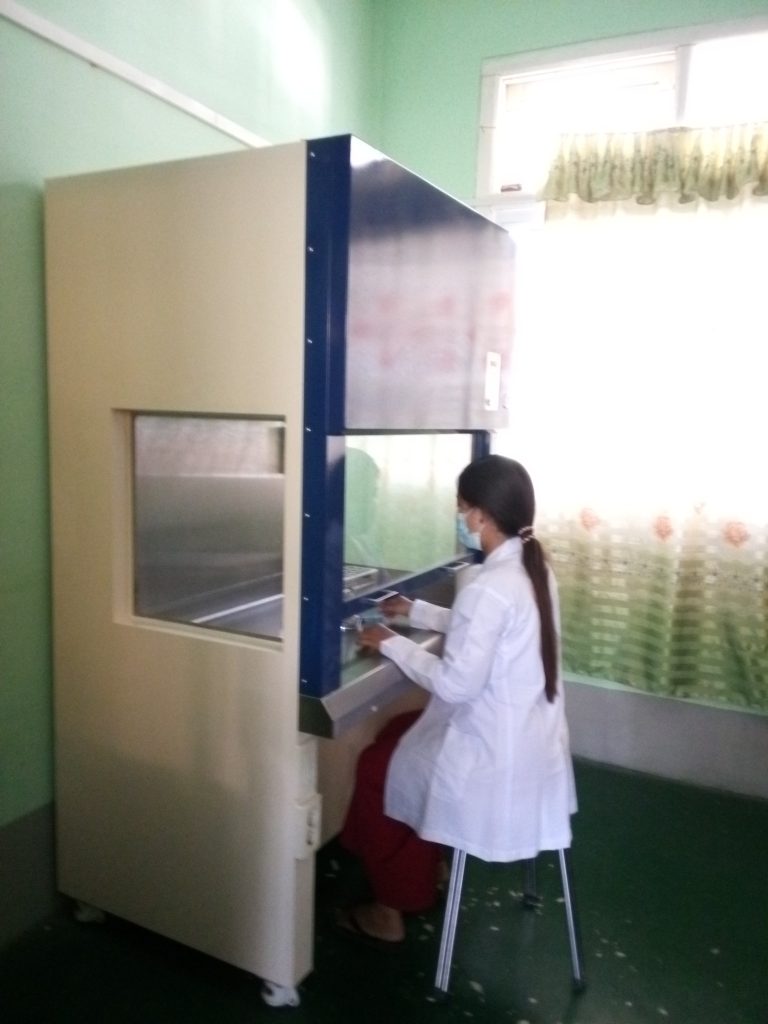 |
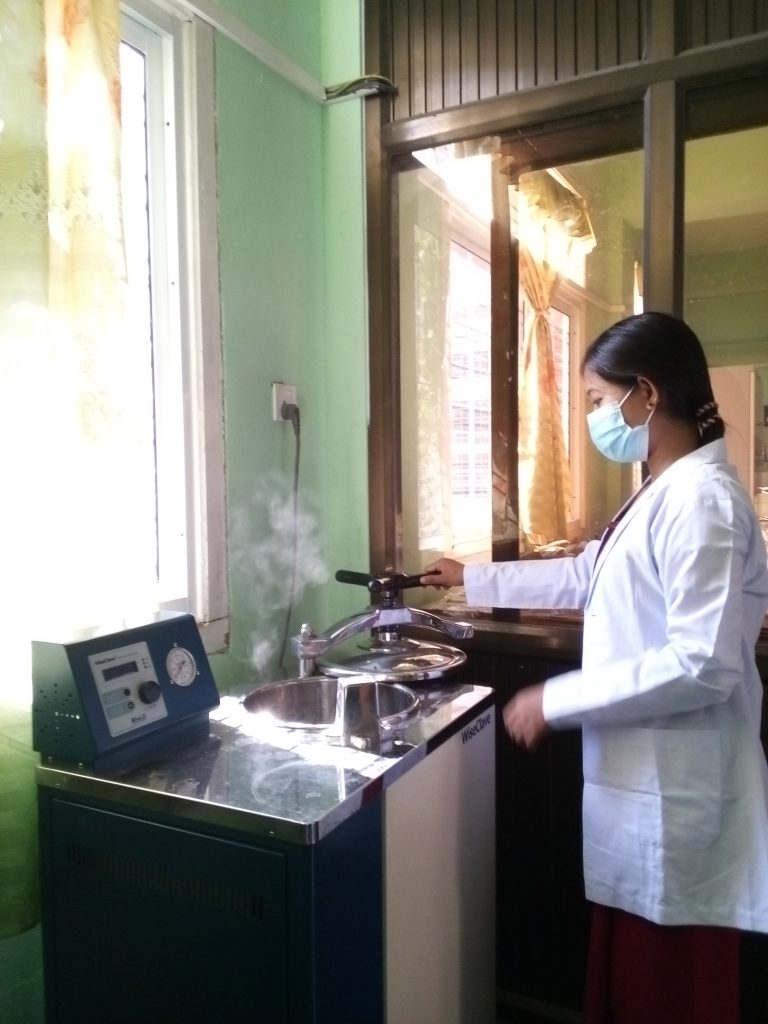 |
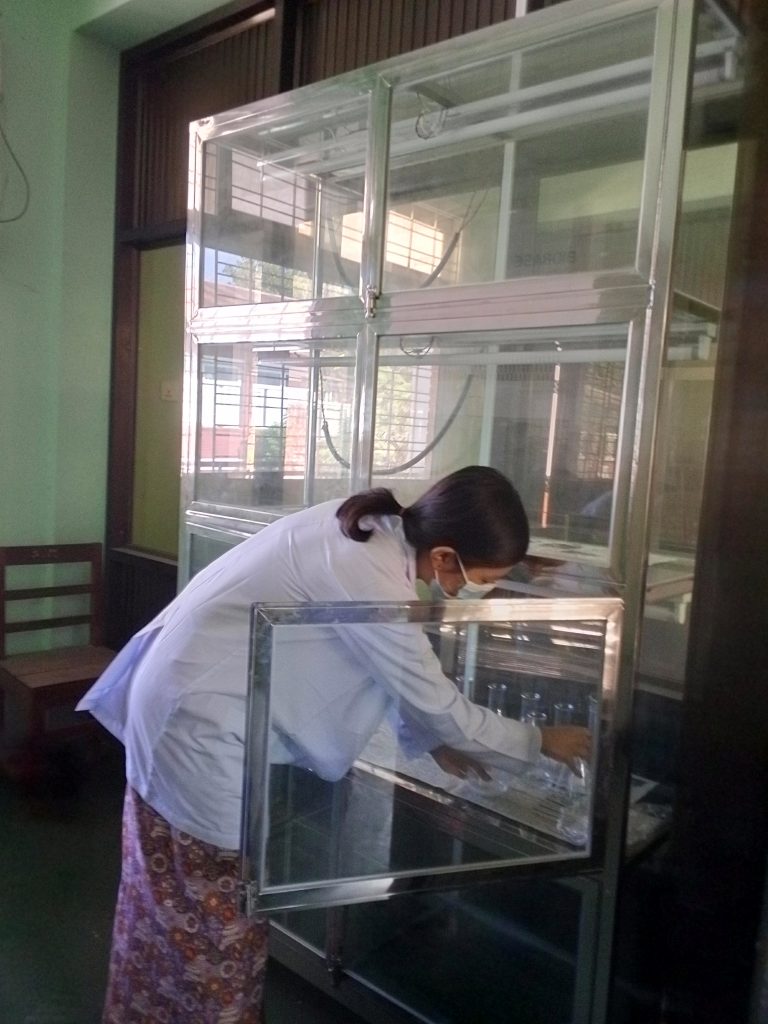 |
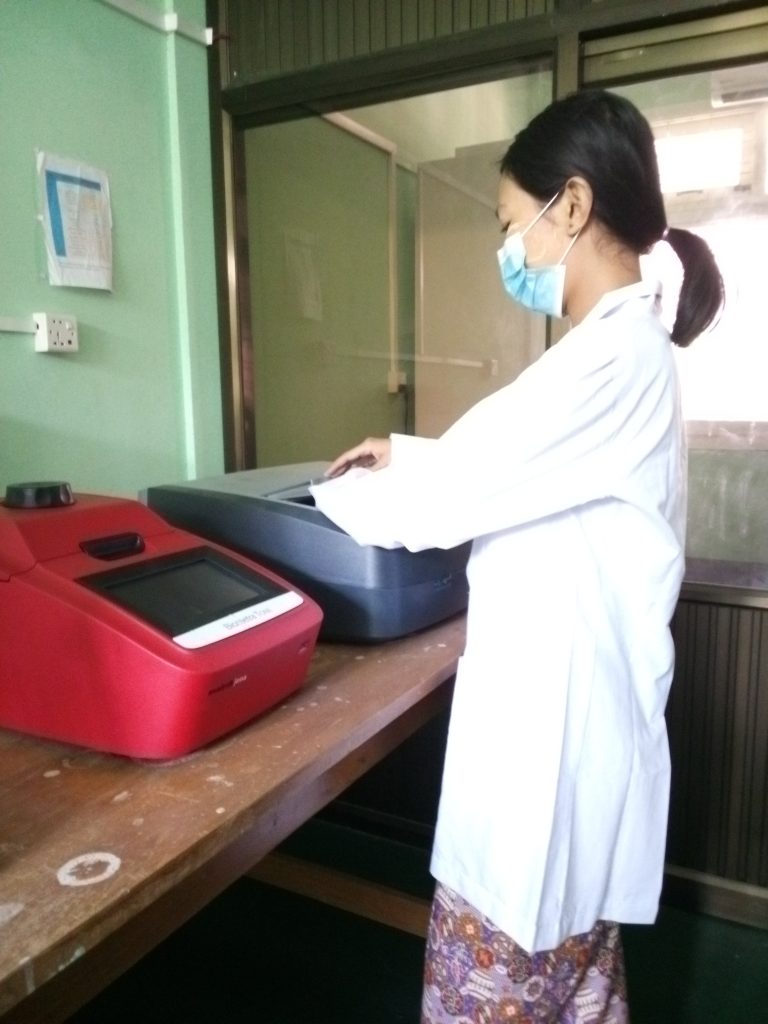 |
Books


